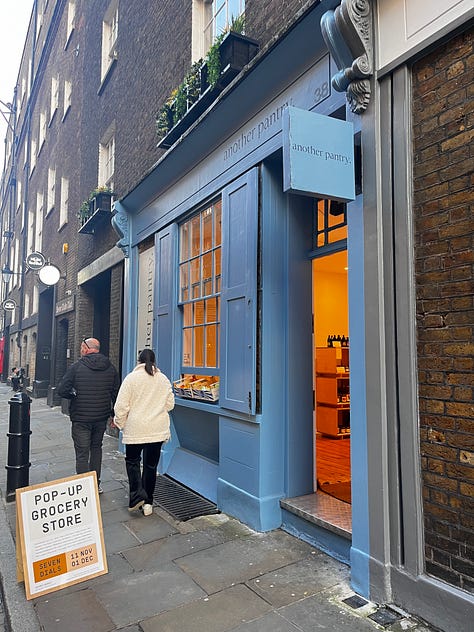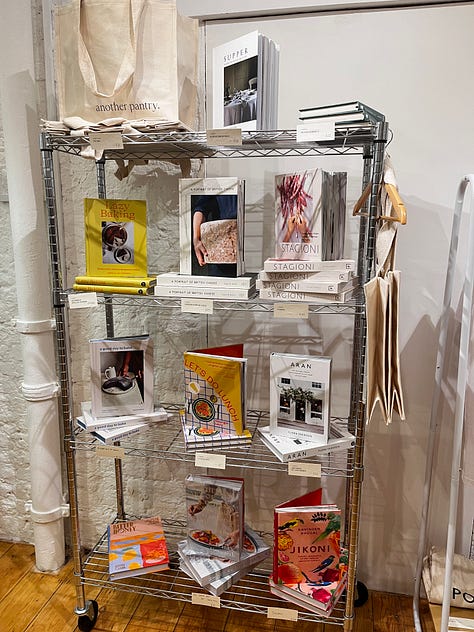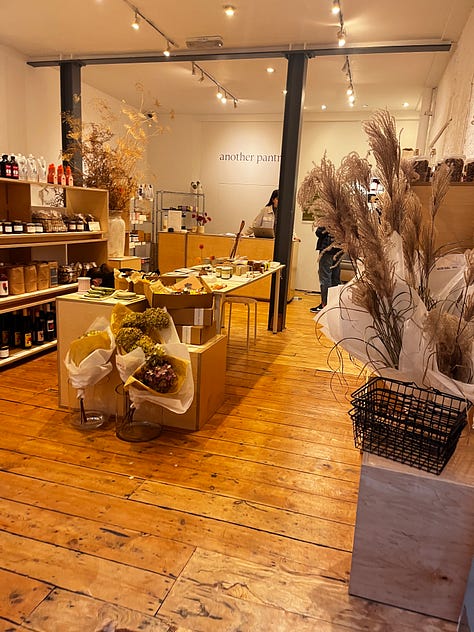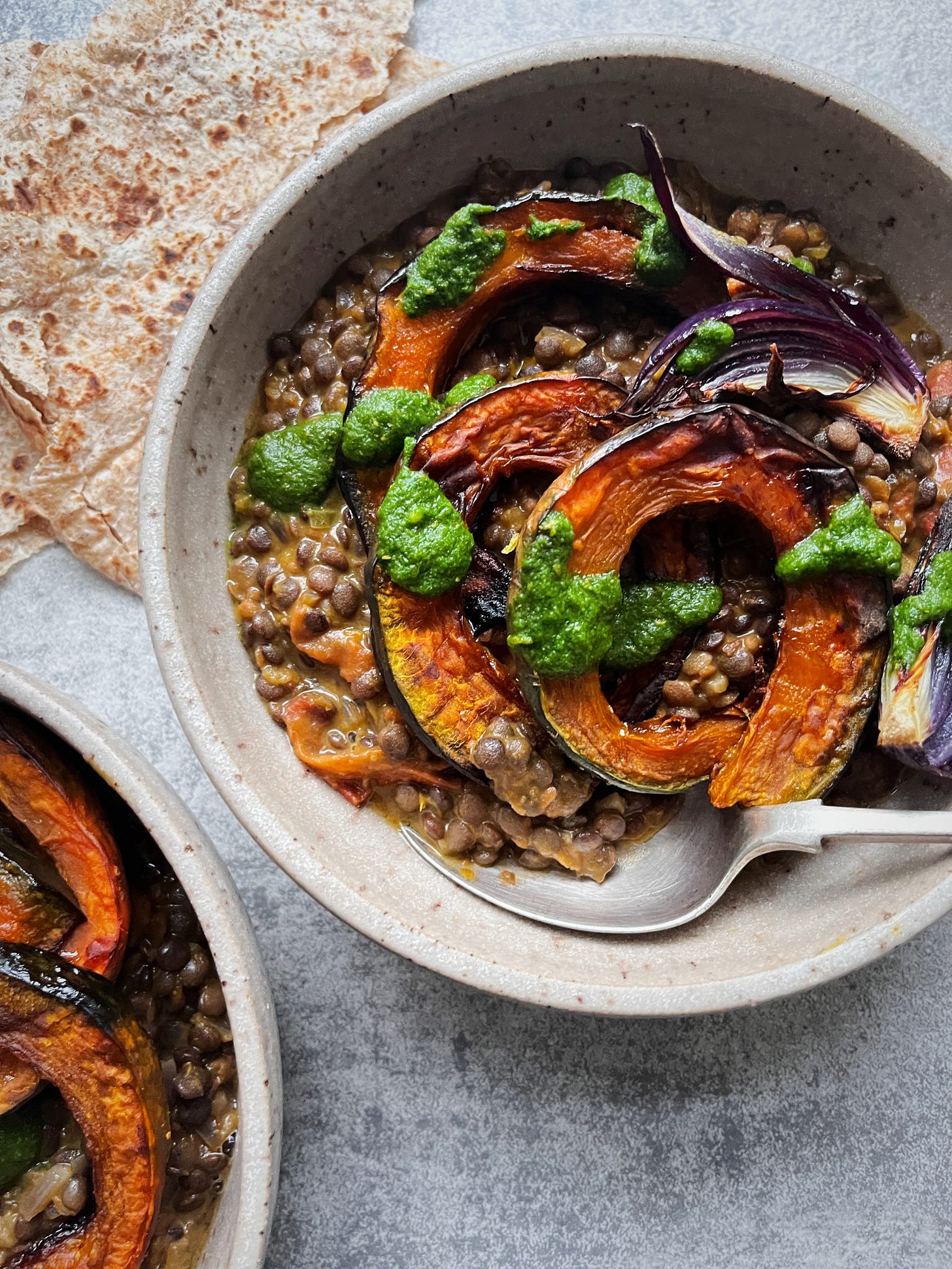What I’m currently consuming
The Spice Blends: Jida
‘Tis the season for getting some warming spices into your food. But often the key to successfully harnessing the power of spices is balance, something which is hard to achieve when you’re hurriedly throwing things into your hot pan. The answer? Let someone get the spices prepared for you.
Here enters Jida. A small company, founded by an Israeli who was missing the scents of home. There are six distinctive spice blends, inspired by Middle Eastern and Mediterranean cooking, that can be added to a whole range of dishes from stews to dips, to add depth of flavour and interest. I’m a full-on fanatic for their Smokin’ blend, a mix of different paprikas, caraway, cumin and Persian lemon that I love rubbed on grilled chicken thighs. 🎁You can buy the range as a gift set, which, let me tell you, would make a mighty fine gift to keen cooks of any level.🎁
The Takeaway: DabbaDrop



I’ve been hearing the name DabbaDrop a lot recently and so I thought it about time I got a taste. The business was set up by Renee and Anshu, big takeaway fans who had got tired of a lack of veggie options, impersonal delivery transactions and piles of plastic - and saw a way to revolutionise the industry.
Their food comes in re-usable steel Dabbas - a great alternative to the single-use plastic that depressingly clogs up our drawers and the world’s landfills. But what’s more, it’s delivered on pushbikes or e-bikes and you just hand back your previous tin. And what about the food, you cry? It’s delicious They offer the most wonderful vegetarian South Asian dishes, with upcoming menus from Sri Lanka, Hyderabad and Kerala that you can subscribe to weekly or fortnightly with pausing at any time. 🎁 They offer giftcards and subscriptions too🎁
The Shop: Another Pantry Pop-up
38 Earlham Street, Seven Dials, WC2H 9LH






Christmas shopping for your loved (foodie) one just got a whole lot easier. Another Pantry, a brilliant community-driven platform founded by Safia Shakarchi (top left) that brings together the best seasonal recipes all in one place, has popped-up as a shop in Covent Garden. Safia has created what can only be described as the ultimate grocery store, with carefully curated sauces, home made curry pastes, ferments, spice mixes, cakes and vermouths from some of London’s most exciting small businesses and restaurants. All the big names are there: Sambal Shiok’s laksa paste, Dishoom’s chutneys and chai, Little Duck Picklery’s pickles and krauts and WildFarmed flour. There are ceramics, cookbooks, napkins and handmade wooden utensils. 🎁 It’s on until 4th December so you still have a chance to get down there and grab something delicious 🎁
Something to fill you up
Creamy Roast Pumpkin Black Dahl
This has loads of fun things going on: a rich, dark dahl with loads of warming cardamom, caramelised roast pumpkin, crispy onions and the perkiest fresh green chutney to cut through it all. I’m doubling down on the pumpkin flavour here by stirring it into the dahl and serving it on top too. Eat it with some chapatis and save those leftovers for the freezer. Use oat cream to make this vegan.
Watch my how-to video here
300g green or brown lentils or black urad dahl, rinsed
1 cinnamon stick
800g pumpkin or squash, such as Delica, Kombucha or Crown Prince
1 large tomato, cut into wedges
2 red onions, one cut into wedges, the other chopped
4 tbsp olive oil
8 cardamom pods, seeds ground
1 ½ tsp cumin seeds
1 tsp mustard seeds
3 garlic cloves, chopped
1 green chilli, chopped
3 tbsp double cream or vegan oat cream
For the coriander chutney
1 small garlic clove, chopped
½ green chilli
½ small bunch coriander (60g)
A handful of mint leaves
¼ tsp cumin seeds
Juice of 1 lime
Make the lentils first. Place them in a large pan and cover with plenty of water, the cinnamon stick and 1 teaspoon of salt. Bring to the boil, then summer for approximately 45 minutes or until very soft, a little overcooked is absolutely fine. Top up with water when they need it.
Meanwhile, preheat the oven to 220C/200C fan/gas 7. Line a baking tray with greaseproof and rub the pumpkin with 2 tablespoons of olive and seasoning. Spread out on the tray along with the tomato and the onion wedges. Place in the oven for 35-40 minutes until everything is tender and crisp on the edges.
Get ahead with the coriander chutney by placing everything in a blender (chop without the lime juice if using a food processor) and whizzing until smooth with a pinch of salt.
Just before the veg comes out the oven, warm the remaining 2 tablespoons of oil in a medium pan and add the crushed cardamom, cumin and mustard seeds. As soon as they begin to sizzle (ie 5 seconds), add the onion, garlic and green chilli and fry, stirring for 8-10 minutes until coloured and soft. As soon as the veg comes out the oven, strip off the skin of a quarter of the pumpkin slices and throw into the onions with the roast tomato and mash them in so you have a puree. Stir this into the cooked lentils along with the cream. Add a little water so it’s your desired thickness and bring everything up to a simmer. Cook for 5-10 minutes just to allow everything to mingle, then season to taste and transfer to bowls and top with the pumpkin and crispy onions and spoon over the coriander chutney. Eat with chapatis.
Something to finish you off
This recipe comes from the wonderful Nadia Caterina Munno aka The Pasta Queen, an Italian social media entertainer and author who is much loved for her feel-good videos, fabulous kitchen and and mouth-watering pasta recipes. I received her new book last week and the first thing to catch my eye was this recipe, called very simply, Pasta Cake.
Pastiera di Taglioni
Pasta Cake
Who says that pasta can’t be a dessert? Or that a sweet pasta can’t be a main course? For hundreds of years, pasta was dressed with sauces that would be considered sweet by modern standards, not unlike the classic spiced holiday sweets of Italy today. Pastiera di tagliolini, an Easter speciality of my Nonna Caterina’s, is part of this tradition. Her ancient recipe combines long, thin pasta strands cut from Sfoglia all’Uovo with a sweetened egg and candied fruit mixture that is then baked for the ultimate surprise. Each slice is a reminder that our ideas of what’s ‘right’ in terms of flavour were made to be challenged – and in fact, sometimes the most inventive dishes can go back to the ones that were most traditional.
Makes one 23-25cm cake (4 servings)
Total prep and cooking time: 1 hour 10 minutes
60g unsalted butter, plus more for greasing
150g light brown sugar, plus more for sprinkling
5 large eggs
1 tsp vanilla extract
1/4 tsp orange blossom water
1 tsp ground cinnamon
30G candied orange peel, cut into 1cm dice
Grated zest of 1 lemon
Sea salt
Softened butter, for the pan
450g fresh tagliolini, homemade or store-bought
240ml whole milk, well chilled Icing sugar, for dusting
Preheat the oven to 190°C/170°C fan/gas 5.
Bring a large pot of water to a rolling boil over high heat. Meanwhile, in a stand mixer fitted with the paddle attachment (or in a bowl with a hand mixer), beat the butter and brown sugar until smooth and fluffy. Add the eggs, vanilla, orange blossom water, rose water, cinnamon, candied orange peel and lemon zest and mix until smooth and silky.
Butter the bottom and sides of a 23-25cm round tart or springform tin. Once the water has reached a rolling boil, season with a pinch of salt. Drop in the tagliolini and cook until the pasta is tender, about 30 seconds.
Transfer the pasta to a bowl and pour the cold milk over it to cool it down and stop it from cooking further. Add the butter/egg mixture to the pasta/milk mixture and mix by hand. Transfer to the tin and smooth out with a spatula.
Bake until golden, about 1 hour. Serve cut into wedges and dust with icing sugar.
Know your onions
The key to great cooking is all in your treatment of your onions.
Cut an onion uniformly so each piece cooks evenly and you’re halfway to deliciousness. We all want to avoid the miserable situation in which some bits are burnt while others are still raw as this gives your food a very odd flavour.
So how do you achieve evenly-cooked onions? It’s all about controlling the Maillard reaction. This is the reaction between sugars and proteins that occurs upon heating that produces browning (ie caramelisation) of some foods. There are many ways that you can figure out how to control it, so let’s talk about them…
ESTABLISH what kind of cooked onion your recipe needs and how much Maillard you want. A caramelised onion found in French onion soup will require a long, drawn-out Maillard; the hard-fry often found in South Asian dishes will require a quick Maillard; and a pale, sweated onion in dishes such as risotto will need only a small amount of Maillard.
DECIDE how the onion should be cut. Chopped? Finely or roughly? Or sliced? Thinly or roughly? My rule of thumb is if I want the onions to disappear into the background, I’ll chop, but if I want to see or feel the texture of onion, then I’ll slice.
SIZE matters. If your pieces are too big, the outside will burn while the middle is still raw. Too small and your onion will dry out too quickly and/or fall apart. But don’t worry, that perfect size is a pretty big window. And the truth is, as long as they’re evenly cut, you’ll be fine.
FAT. Which one should you go for? This depends on the dish you’re making. Something rich and indulgent - butter. Something a bit lighter - olive oil. Butter and onions are an incredible combination, but butter has a low smoke point so can quickly burn and give the appearance of false doneness. So when I’m taking the butter route, I’ll add a splash of oil to increase its smoke point. Make sure there’s enough fat otherwise you’re heading straight to Burn Town.
SALT or not to salt? Adding salt creates osmosis (Maillard’s greatest foe) and therefore delays the Maillard process, so if you want to achieve a rich, caramel flavour with the onion still holding its shape, no salt during cooking. But if you want to sweat your onion for a long time, get loads of flavour out of it but avoid burning, then salt is essential.
PAN around. This is crucial and the number one reason people burn their onions. If your pan is too big (onions don’t cover the base), the onions will give up their moisture too quickly and burn before they caramelise. If it’s too small (the onions come higher than your first knuckle), they will steam and not get enough pan contact to achieve Maillard so you’ll just get soggy mush.
HEAT it. OK OK, maybe this is the number one reason for burning! The answer is straightforward though: low-medium. You want to be able to hear a quiet, happy sizzle. The sizzle will get more urgent and less quiet as you approach doneness (ie the water has cooked off and the onions are beginning to colour). It’s best to play around with the other factors (time, salt and pan size) if you want to affect the outcome. Rushing an onion is never a good idea.
TIME for it. This is a big area of contention in the cooking world as many chefs feel modern recipes in their desire to look quick and easy, often don’t encourage a long enough onion cooking time. As a recipe writer, you know many people will be put off by an opening method of “first cook your onions for 12 minutes”, but sadly, this is often the minimum of how long it really takes to get all the flavour out of an onion. There is nothing worse than being able to taste raw onion in your food, so longer is better. They provide that rich depth of flavour that is at the heart of soups, stews and sauces. However, if post frying, the onion is going to carry on being cooked in liquid ie in a soup or stew, then you can get away with less cooking, as long as you have a taste and make sure you’ve cooked out the raw flavour.
VARIETY shows. Red, yellow or white? And does it matter? White is very different to the other two as it’s much sweeter, milder and more watery. It works best when raw to add bite; it’s particularly good in salsas. Yellow and red are more interchangeable. Some say red is a bit sweeter while yellow is more pungent, but I tend to just approach them in terms of their colour and appearance. If I’m cooking something pale such as a white risotto, then it’s yellow. If it’s a dark beef dish, then I’ll chuck in red ones. But you know what?
It doesn’t really matter as long as you don’t rush them and don’t burn them!













